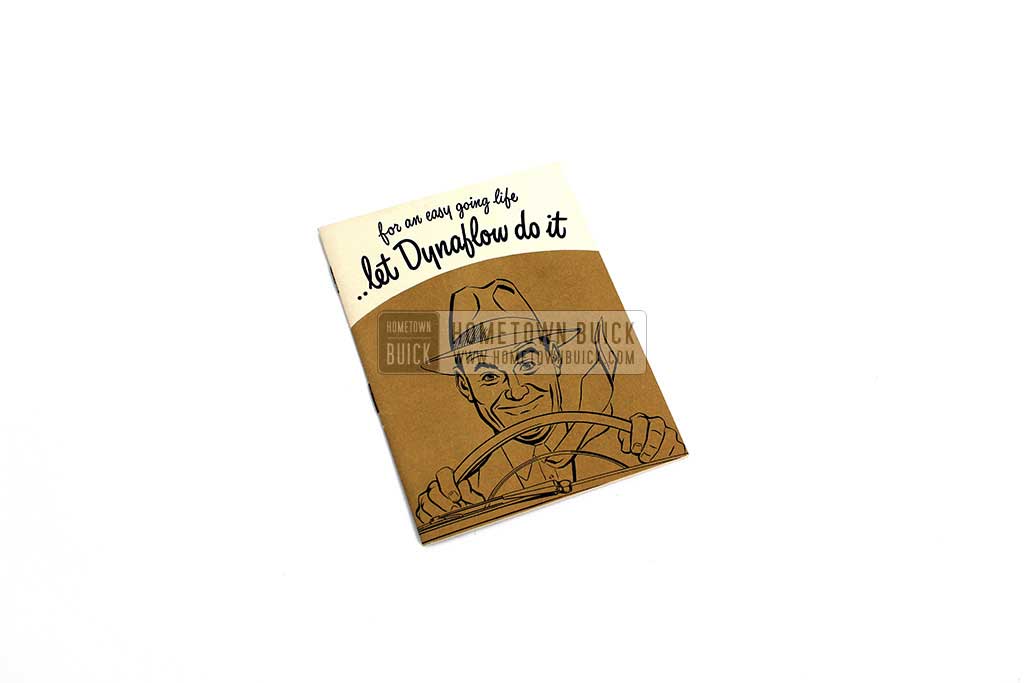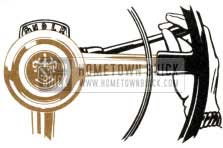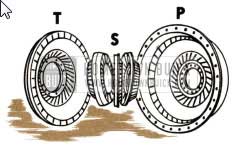
The Information Source
The content of this page reflects the 1950 Buick Dynaflow Transmission booklet.
Let’s start with an admission.
Most of us like to do things the easy way. If one motion will do the work of two we prefer one motion. If we can free our minds of things we once had to remember-we would rather do so. If we can drive all day long with nothing to concern us but steering and pressing the accelerator, we certainly will choose the way that leaves us fresher and in better spirits than if we’re constantly under tension. So while 1950 Buick Dynaflow Drive stands as one of the great automotive engineering accomplishments of all time-perhaps the big thing about 1950 Buick Dynaflow Transmission to the average driver is that “There’s nothing to it!”
You can lead an easygoing life behind the wheel-and know a brand-new measure of smoothness, restfulness, ease and pleasure. This booklet about the 1950 Buick Dynaflow Transmission seeks to show you how and why.

all you have to think about with the 1950 Buick Dynaflow Transmission
Controls for 1950 Buick Dynaflow Transmission Driving are just about as simple as you can imagine. A foot-brake, an accelerator and this control lever under your wheel-that’s all there are. No clutch pedal and no gearshift lever of the usual sort. Now look at the various positions of the control lever, starting at the left.
There is “P” for PARKING-the position in which you leave the control when you park. It drops a steel bar into a gear so as to mechanically Jock rear wheels-a more positive lock than any kind of parking brake.
This is also one of the two positions for starting the engine.
Next is “N” for NEUTRAL – just like neutral on any car. Use it in the same way. In this position your rear wheels are disengaged from the engine. So don’t leave your car standing on a grade in this setting unless your foot parking brake is firmly set. This is the other position in which the engine may be started.
Now comes “D” for DRIVING-the setting you will use most. Set the lever here for all normal forward travel.
“L”, which is next, stands for EMERGENCY LOW, a very powerful setting-more powerful than low gear on any conventional car. You will rarely need this reserve setting except:
(1) For starts with a heavy load on very steep grades.
(2) For reserve braking action on steep downgrades.
(3) For slow, hard pulls out of very tough spots or possibly for “rocking” the car out of sand or snow.
what you do in certain situations
The telling is really much more complicated than the doing, but let’s run through some common driving situations and see how the 1950 Buick Dynaflow Transmission handles them.
TO START THE ENGINE
To prevent starting the engine with the car “in gear,” so to speak, your car has been designed so that the engine will not start except when the control lever is in “P” or “N” position. So lift the lever a little and move into either of these settings. Then turn on the ignition and step on the accelerator.
TO MOVE AWAY
To get under way, let the engine idle and move the control lever into “D” setting. Press the gas treadle, and you will move away, smoothly and easily, your speed regulated by your foot pressure on the accelerator. At this point notice certain things:
No clutch work, of course. We pointed out that the 1950 Buick Dynaflow Transmission has no clutch pedal. You make a very smooth start-so smooth you may not realize how rapidly you are picking up speed. At first, better glance occasionally at the speedometer to get the sense of how you are accelerating. Customary gear-whine is gone. No gears are turning on each other in the transmission. You do hear the engine-largely because you hear no gear-whine. If it seems to be running faster than usual, don’t worry. It is running at practically the same speed as it would in a gearshift car. You are just more aware of it because gear-noise doesn’t drown it out’.
TO REACH CRUISING SPEED
Just feed enough gas to get the pace you want-that’s all. There is no need either to lift you r foot to let a gear changer shift for you, or to wait for a “click” to tell you that it has done so. 1950 Buick Dynaflow Transmission gets you up to road speed in one smooth, velvety, unbroken flow of power.
ON APPROACHING STOP LIGHTS
Release your foot pressure and the car will slow down not abruptly but with smooth deceleration. Apply the foot brake as necessary to stop. But don’t touch the control lever-you’re through with shifting.
ON GETTING AWAY AGAIN
Just press down the gas treadle-gently and smoothly just enough to start moving again. At this point let us remind you-we’re taking things easy! It’s fun, of course, to “tramp on it” and get away with a rush, showing the other fellow how much power you have. And you can do that with Dynaflow by pressing the treadle down hard. But it is quite unnecessary. The other fellow, remember, probably has to shift, either manually or automatically. By the time he has gone through second and into high each time with a break in stride – you are up with him, possibly ahead, all with one smooth, easy build-up of speed. Just let the 1950 Buick Dynaflow Transmission do it, in its own smooth, velvety and completely competent way. You can step out smartly without wasting gas by a too-heavy foot on the treadle.
PASSING OTHER CARS
First of all, obey the simple safety rules of the road and be very sure the road is clear. Then get around the other fellow quickly. With the 1950 Buick Dynaflow Transmission you just step on it, and you’ll feel a prompt, answering surge of passing speed. Once around, slip back into your lane and settle down to your usual easy going way.
CLIMBING HILLS
Stop and think about this a moment. Most of us rush at a hill, pushing the engine, possibly gripping the wheel extra tight, being very tense about it. This isn’t necessary with Dynaflow. The grade will slow you down a bit, of course. But just a touch more gas will pick up your speed again. Indeed, it is sometimes hard to realize how little more gas is needed to maintain your pace. But this drive doesn’t have to be pushed! Just “let Dynaflow do it” and enjoy yourself.
GOING DOWN GRADES
In any lever setting, the engine will have a braking effect if you lift your foot entirely from the gas treadle. If the grade is very steep-the kind where signs say “Shift into Lower Gear”-check your speed to 35 miles with the foot brake and move the control lever into “L” setting. Occasional intermittent application of the foot brake will give you complete control.
PULLING OUT OF HEAVY GOING
If the ground is dry and the traction good, move your control lever into “L” and gently apply power. Here again, let Dynaflow do it. The “L” setting gives more power than any ordinary low gear, so don’t rush it. A gentle steady foot pressure gives best results.
ON SLIPPERY GOING
Here the problem is to avoid spinning the rear wheels, whatever kind of drive you have. With Dynaflow, set the lever in “D” and feed gas slowly and evenly. If you let the 1950 Buick Dynaflow Transmission do it, you can pull away smoothly. Lose your patience and you can spin your wheels as with any other drive.
You have an additional asset in that Dynaflow will not change gear ratios in the midst of such an operation.
“ROCKING” YOUR CAR
Sometimes in snow or deep sand you can get out only by “rocking” the car backward and forward. You can do this with Dynaflow in this way:
Lift the control lever a little and move it slowly back and forth between “L” and ‘”R”. Feed gas lightly, only enough to get motion-forward and back, forward and back. Remember that both “L” and “R” settings are extra powerful, and rushing matters may only spin your wheels.
STARTING WITH A DEAD BATTERY
In the event of a dead battery, the engine can be started by pushing the car. With ignition on, set the selector lever in “N” and push the car until 30 or 35 miles per hour is reached. Then move lever to “D” and feed gas lightly.
TO BACK UP
It is necessary to lift the lever a little to move into the “R” setting. This is to prevent accidental movement from “L” to “R”. So to back up, lift the lever and slide it to the right-then apply power. Take it easy because of the extra power in the “R” setting. Indeed, many drivers rest their left foot on the foot brake while backing, controlling speed both with the brake and the accelerator.
some other interesting points about the 1950 Buick Dynaflow Transmission
As you see, Dynaflow is a transmission which does not have to be pushed to deliver its best. Indeed, just let Dynaflow do it – and you’ll really have an easygoing time.
But there are some other things…
With 1950 Buick Dynaflow Transmission Drive power is transmitted through oil instead of through gears. So each mile is smoother and more restful, free of geared-drive harshness. There is so little for the driver to do with Dynaflow that day-long driving is much less tiring. Tension and nerve strain are lessened, so you feel much less the effect of several hundred miles behind the wheel. There is restfulness and comfort, too, in starts and stops that are smooth and easy, never abrupt and jerky. On top of that, the whole running mechanism takes fewer shocks with Dynaflow Drive. Engine parts are oilcushioned against sudden loads and strains so take less wear and tear. Service requirements are very low on Dynaflow. The only regular attention you need give the unit is to check the oil level occasionally. Another point can be mentioned-this time dealing with economics.
Records show that used Buicks equipped with Dynaflow Drive command an extra premium almost equal to the extra first cost of the drive. Thus in spite of the fact that Dynaflow Drive is optional equipment at extra cost on all Buicks except ROADMASTER, it costs little if any extra when resale values are calculated.

how the 1950 Buick Dynaflow Transmission works
The heart of 1950 Buick Dynaflow Transmission Drive is a unit like this, known to engineers as a torque converter. These are contained in a sealed drum completely filled with oil. Part P -the Pump – is connected with the engine and revolves with the crankshaft. Part T-the Turbine-is connected with the drive shaft which rotates the rear wheels. Rotated by the engine, the Pump drives oil against the blades of the Turbine, tending to make it revolve. To this extent, the unit is somewhat like the ordinary fluid clutch.
But Dynaflow Drive is set apart from others by the additional parts S, called Stators. These serve to direct the flow of oil within the unit in different paths. According to the path the oil takes, the engine’s torque (or twisting force) is either multiplied in various degrees or transmitted direct.
This is normally the function of gears in the ordinary transmission. Low gear, for instance, multiplies “torque” about two-and-a-half times to provide the extra power needed to get a car started. Second gear multiplies “torque” to lesser degree, thereby giving you the power needed for acceleration, hill climbing, etc. High gear, of course, transmits power direct, without multiplying torque.
The 1950 Buick Dynaflow Transmission makes all such gears unnecessary, whether they are shifted manually or automatically. It works like this:
At idling speed, your engine does not have enough power to get the dead weight of the car moving. So as you apply power, the oil in the unit seeks the path that will multiply torque enough to start the car.
As your car begins to roll, less and less torque multiplication is needed. So the unit again adjusts itself to whatever multiplication is required. By the time you reach cruising speed, oil is traveling in a path that transmits engine power direct. This constant self-adjustment takes place every minute you are under way. For example, should you come to a hill that would call normally for a shift to second gear, the extra pull on the engine would cause the oil to change paths to a more powerful one. The adjustment is always made so smoothly you are not aware of it. It is not accomplished by the shifting of gears, but by the smooth flow of a liquid in a different way. Thus you could boil matters down to this: Oil, traveling in different paths in a self-adjusting device, does what a sequence of gears once had to do. And it does it with wonderful smoothness and ease. Just let the 1950 Buick Dynaflow Transmission do it and you’ll lead an easygoing life behind the wheel.

Leave A Comment
You must be logged in to post a comment.